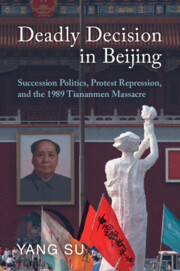Book contents
- Deadly Decision in Beijing
- Deadly Decision in Beijing
- Copyright page
- Epigraph
- Contents
- Figures
- Tables
- Preface
- Acknowledgments
- Main Characters
- Chronology
- Abbreviations
- 1 Introduction
- Part I Party-State Leadership in the Deng Era
- Part II Elite Politics and the Making of the Tiananmen Protest
- 4 Early Response and the Growth of the Protest
- 5 Where Was Deng Xiaoping?
- 6 How a Moderate Approach Failed
- Part III The Decision for Military Intervention
- Part IV The Political Impact
- Notes
- Index
4 - Early Response and the Growth of the Protest
April 15–April 26, 1989
from Part II - Elite Politics and the Making of the Tiananmen Protest
Published online by Cambridge University Press: 23 February 2023
- Deadly Decision in Beijing
- Deadly Decision in Beijing
- Copyright page
- Epigraph
- Contents
- Figures
- Tables
- Preface
- Acknowledgments
- Main Characters
- Chronology
- Abbreviations
- 1 Introduction
- Part I Party-State Leadership in the Deng Era
- Part II Elite Politics and the Making of the Tiananmen Protest
- 4 Early Response and the Growth of the Protest
- 5 Where Was Deng Xiaoping?
- 6 How a Moderate Approach Failed
- Part III The Decision for Military Intervention
- Part IV The Political Impact
- Notes
- Index
Summary
Chapter 4 examines the actions and, as importantly, the inactions of state leaders in the early period of the student protest, from April 15, the day of Hu Yaobang’s death, to April 26, the day of the publication of the government’s first official response in the form of an editorial. The focus is on the first-line leaders in charge of day-to-day governance, especially General Secretary Zhao Ziyang and Premier Li Peng.
- Type
- Chapter
- Information
- Deadly Decision in BeijingSuccession Politics, Protest Repression, and the 1989 Tiananmen Massacre, pp. 75 - 94Publisher: Cambridge University PressPrint publication year: 2023

